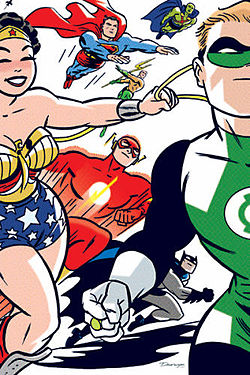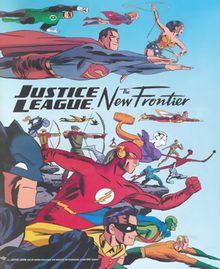- DC: The New Frontier
-
DC: The New Frontier 
Front cover to Absolute DC: The New Frontier. Art by Darwyn Cooke.Publication information Publisher DC Comics Schedule monthly Format Limited series Publication date 2003-2004 Number of issues 6 Main character(s) Hal Jordan, Martian Manhunter, Superman, Wonder Woman, Flash, Batman, various DC characters Creative team Creator(s) Darwyn Cooke DC: The New Frontier is an Eisner, Harvey, and Shuster Award-winning six-issue comic book limited series written and drawn by Darwyn Cooke, published by DC Comics in 2003-2004. It was then collected into two trade paperback volumes from 2004–2005 and then an Absolute Edition in 2006. The story was adapted as an animated movie titled Justice League: The New Frontier, and released on February 26, 2008.
The series was influenced by works such as Kingdom Come, The Golden Age, Watchmen, and Batman: The Dark Knight Returns. Much like The Golden Age, New Frontier takes place primarily in the 1950s, and depicts the Golden Age superheroes Superman, Batman, and Wonder Woman meeting Silver Age characters the Flash, Green Lantern, and Martian Manhunter. The story bridges the gap from the end of the Golden Age to the beginning of the Silver Age in the DC Universe.
Contents
Plot
World War II is over and the Cold War has begun. The Age of the Superhero is in decline. Superman, Wonder Woman and Batman, who survived the anti-hero sentiment of the Cold War, as well as eager newcomers like test pilot Hal Jordan and scientists Barry Allen and Ray Palmer, team up to defeat a threatening alien presence on Earth.
Setting
The New Frontier is set in 1945, 1948, and 1952-1960. Cameos from the likes of President Dwight D. Eisenhower and Vice President Richard Nixon, as well as references such as the atomic testing, civil rights movement, and the Soviet Union, are done to give a sense of the era the series is set in. The storyline draws inspiration from the comic books and films of the period, as well as both the novel and film The Right Stuff by Tom Wolfe. The series attempts a dynamic re-imagining of the era that ushered in the presidency of John F. Kennedy. A major part from one of his speeches is used and the title also invokes John F. Kennedy's use of the term New Frontier.
Continuity
The continuity that New Frontier is set in could be best described as a "best of both worlds" where the two eras of the Golden and Silver Ages, both different as one was created from the pulp magazines and the other mainly from the genre of science fiction, are now in coexistence. Also, there are some traditional elements from the DCU applied in the series that aren't Golden or Silver Age-related such as the cameo appearances of Harvey Bullock, Darkseid, who didn't appear until the 1970s and 1980s.
Another factor is that many of the characters appeared when they were created, and not retconned to fit the era and story around them. As explained by Darwyn Cooke himself, from a fan podcast called Fanboy Radio, "all retcons are irrelevant; the only continuity that matters is the 'prime continuity' established in the first year by the guys who created the strips. I'm following the exact continuity of the original books in the original time they occurred." For example, the Martian Manhunter lands on Earth in 1953, the same year in which the Golden Age Manhunter from Mars, Roh Kar, was created, who served as the character's prototype until J'onn J'onzz's actual first appearance in Detective Comics #255 as Detective John Jones in 1955. Barry Allen becomes The Flash in 1956, the same year as his first appearance in the comics, and Hal Jordan acquires the power ring and becomes Green Lantern in 1959, again just like the story.
Although Cooke considers New Frontier to take place in pre-Crisis on Infinite Earths continuity, he nevertheless did not employ the period-accurate Earth-One and Earth-Two Multiverse concepts. Thus, he effectively uses a variation of the post-Crisis continuity whereby the Golden and Silver Age heroes both exist in a unified timeline rather than separate realities.
Subsequently, the New Frontier universe, or a very similar version of it, has been identified as one of the 52 Earths in the current DC multiverse, designated as Earth-21.
Art Style
The art style has several influences: Jack Kirby from the squared fingers, muscles and jaws; the simple clean lines of Golden Age-era comics. The past deco-aesthetics from the Fleischer Superman cartoons to the more modern deco-aesthetics from Batman: The Animated Series, and a number of other shows in the DC animated universe. Cooke had previously worked as an artist for many of the latter. Cooke's style also has similarities to that of Bruce Timm.
Awards
Since its release, the series won the Eisner Award for Best Limited Series, Best Coloring, and Best Publication Design. It also won the Harvey Award for Best Artist, Best Colorist, and Best Continuing or Limited Series. In addition, it received the Shuster Award for Outstanding Canadian Comic Book Cartoonist (Writer/Artist). In 2007, when the series was released as an Absolute Edition, the series gained another Eisner and Harvey Award for Best Graphic Album (Reprint) from Eisner, and Best Graphic Album of Previously Published Work from Harvey.
Film adaptation
Main article: Justice League: The New FrontierAn adaptation was made as a direct-to-video animated film, written by writer Stan Berkowitz, produced by Bruce Timm, with Darwyn Cooke serving as story and visual consultant. Rated PG-13, it was released in the United States on February 26, 2008 on DVD, HD DVD and Blu-ray Disc, with pay-per-view available the day it was released.
Collections
The series has been collected in two softcover collections and one Absolute Edition collection. While the softcover collection reprint the comic as it was when released in issues, the Absolute Edition includes an extra 13 pages of new stories.
- DC: The New Frontier: Volume One (collecting #1-3; ISBN 1-4012-0350-7)
- DC: The New Frontier: Volume Two (collecting #4-6; ISBN 1-4012-0461-9)
- DC: The New Frontier: Absolute Edition (collecting #1-6; ISBN 1-4012-1080-5) [1]
Merchandise
DC Direct produced a line of action figures based on the series, released in July 2006:
- Wave 1 - Blackhawk, Green Arrow, Green Lantern, Superman, and Wonder Woman. Released July 2006.
- Wave 2 - Batman, Dr. Fate, Martian Manhunter and The Flash. Released December 12, 2007.
A subsequent box set of Batman, Superman, Green Lantern and Wonder Woman (with a new head) and including a reprint of Justice League: The New Frontier Special was released in April, 2009.
Follow-ups
A brief addendum appeared in Solo #5 (2005), a collection of short stories written and drawn by Darwyn Cooke. One of the stories, featuring King Faraday, is set in pre-revolutionary Cuba and is titled "Triangulation: A New Frontier Thriller."
In time for the DTV release of the animated adaption Justice League: The New Frontier, Cooke and DC Comics released a follow-up special titled Justice League: The New Frontier Special as a tie-in as well as adding more stories onto the comic version. Stories included a Batman vs. Superman that revealed that it wasn't until the mid-1950s that Superman and Wonder Woman met Batman, a post-New Frontier story where Robin teams up with Kid Flash for the first time as well as a Mad Magazine style story between Wonder Woman and Black Canary.
References
Categories:- DC Comics limited series
- Eisner Award winners for Best Limited Series
- Harvey Award winners for Best Continuing or Limited Series
Wikimedia Foundation. 2010.

